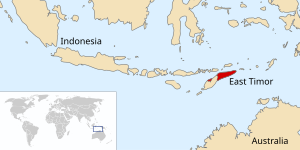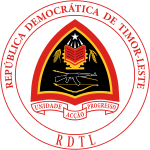| Indonesian occupation of East Timor | |||||||||
|---|---|---|---|---|---|---|---|---|---|
| Part of the Cold War (until 1991) | |||||||||
 | |||||||||
| |||||||||
| Belligerents | |||||||||
| |||||||||
| Commanders and leaders | |||||||||
|
|
| ||||||||
| Strength | |||||||||
| 250,000[2] |
27,000 (including non combatant in 1975)[3] 1,900 (including non combatant in 1999) 12,538 fighters (1975–1999)[4] | ||||||||
| Casualties and losses | |||||||||
|
2,277 soldier and police killed 1,527 Timorese militia killed 2,400 wounded Total: 3,408 killed and 2,400 wounded[5] | 11,907 fighters killed (1975–1999)[6] | ||||||||
| Estimates range from 100,000–300,000 civilians dead (see below) | |||||||||
| History of East Timor |
|---|
 |
| Chronology |
| Topics |
|
|
| Part of a series on |
| Genocide |
|---|
 |
| Issues |
| Related topics |
| Category |
The Indonesian occupation of East Timor began in December 1975 and lasted until October 1999. After centuries of Portuguese colonial rule in East Timor, the 1974 Carnation Revolution in Portugal led to the decolonisation of its former colonies, creating instability in East Timor and leaving its future uncertain. After a small-scale civil war, the pro-independence Fretilin declared victory in the capital city of Dili and declared an independent East Timor on 28 November 1975.
Following the "Balibo Declaration" that was signed by representatives of Apodeti, UDT, KOTA and the Trabalhista Party on 30 November 1975, Indonesian military forces invaded East Timor on 7 December 1975, and by 1979 they had all but destroyed the armed resistance to the occupation. On 17 July 1976, Indonesia formally annexed East Timor as its 27th province and declared the province of Timor Timur (East Timor).
Immediately after the invasion, the United Nations General Assembly and Security Council passed resolutions condemning Indonesia's actions in East Timor and calling for its immediate withdrawal from the territory. Australia and Indonesia were the only nations in the world which recognised East Timor as a province of Indonesia, and soon afterwards they began negotiations to divide resources found in the Timor Gap. Other governments, including those of the United States, Japan, Canada and Malaysia, also supported the Indonesian government. The invasion of East Timor and the suppression of its independence movement, however, caused great harm to Indonesia's reputation and international credibility.[7][8]
For twenty-four years, the Indonesian government subjected the people of East Timor to routine and systematic torture, sexual slavery, internment, forced disappearances, extrajudicial executions, massacres, and deliberate starvation.[9] The 1991 Santa Cruz Massacre caused outrage around the world, and reports of other such killings were numerous. Resistance to Indonesian rule remained strong;[10] in 1996 the Nobel Peace Prize was awarded to two men from East Timor, Carlos Filipe Ximenes Belo and José Ramos-Horta, for their ongoing efforts to peacefully end the occupation. A 1999 vote to determine East Timor's future resulted in an overwhelming majority in favour of independence, and in 2002 East Timor became an independent nation. The Commission for Reception, Truth and Reconciliation in East Timor estimated the number of deaths during the occupation from famine and violence to be between 90,800 and 202,600, including between 17,600 and 19,600 violent deaths or disappearances, out of a 1999 population of approximately 823,386. The truth commission held Indonesian forces responsible for about 70% of the violent killings.[11][12][13]
After the 1999 vote for independence, paramilitary groups working with the Indonesian military undertook a final wave of violence during which most of the country's infrastructure was destroyed. The Australian-led International Force for East Timor restored order, and following the departure of Indonesian forces from East Timor, the United Nations Transitional Administration in East Timor administered the territory for two years, establishing a Serious Crimes Unit to investigate and prosecute crimes committed in 1999. Its limited scope and the small number of sentences delivered by Indonesian courts have caused numerous observers to call for an international tribunal for East Timor.[14][15]
Oxford University held an academic consensus calling the occupation of East Timor a genocide and Yale University teaches it as part of its Genocide Studies program.[16][17]
- ^ Indonesia (1977), p. 31.
- ^ Rei, Naldo (16 March 2011). Resistance: A Childhood Fighting for East Timor. ReadHowYouWant.com. ISBN 9781458767615.
- ^ De Almeida, Ursula (20 August 2023). "Reintegration of Falintil, Timor-Leste's Ex-Combatants, then and Now". Journal of Peacebuilding & Development. 12 (1): 91–96. JSTOR 48602939.
- ^ "East Timor distinguishes 15 "leading figures" of the liberation".
- ^ Van Klinken, Gerry (2005). "Indonesian Casualties in East Timor, 1975–1999: Analysis of an Official List". Indonesia (80): 109–122. JSTOR 3351321.
- ^ "East Timor distinguishes 15 "leading figures" of the liberation".
- ^ ClassicDoc (20 January 2016), Manufacturing Consent – Noam Chomsky and the Media – 1992, archived from the original on 4 March 2020, retrieved 10 February 2017
- ^ Schwarz (1994), p. 195.
- ^ Powell, Sian (19 January 2006). "UN verdict on East Timor" (PDF). The Australian. Archived from the original (PDF) on 28 May 2015. Retrieved 3 December 2013.
- ^ Schwarz (1994), p. 195
- ^ East Timor population Archived 28 August 2019 at the Wayback Machine World Bank
- ^ "Chega! The CAVR Report". Archived from the original on 13 May 2012.
- ^ Conflict-Related Deaths In Timor-Leste: 1974–1999 Archived 25 January 2020 at the Wayback Machine CAVR
- ^ Cite error: The named reference
HRWTribwas invoked but never defined (see the help page). - ^ Cite error: The named reference
IT2was invoked but never defined (see the help page). - ^ Payaslian, Simon. "20th Century Genocides". Oxford bibliographies. Archived from the original on 16 May 2020. Retrieved 12 November 2016.
- ^ "Genocide Studies Program: East Timor". Yale.edu. Archived from the original on 23 March 2020. Retrieved 12 November 2016.
Cite error: There are <ref group=lower-alpha> tags or {{efn}} templates on this page, but the references will not show without a {{reflist|group=lower-alpha}} template or {{notelist}} template (see the help page).